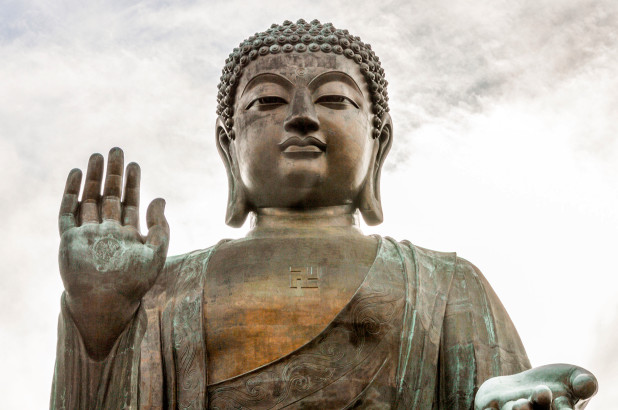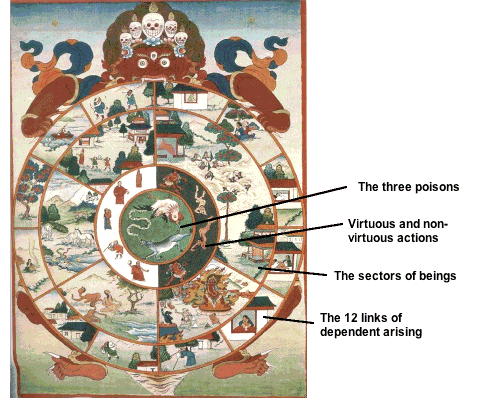SelfDefinition.Org
Buddhism Articles

Twelve Links of Dependent Arising
Twelve Causes of Suffering
Dependent Origination, Causes and Conditions

Image from dharmanet.org
Geshe Sonam Rinchen's comments on the mandala: [fair use, slightly different from the above mandala]
The wheel is divided into sections of which the three lower ones show the realms of hell beings, hungry spirits, and animals. These segments signify the suffering of pain. There are three upper sections representing the human realm, the abodes of the gods belonging to the desire realm, and those of the gods belonging to the form realm. The first two represent the suffering of change, while the latter represents the pervasive suffering of conditioning.
The different kinds of suffering have been caused by contaminated actions underlain by the disturbing emotions. To show how this happens, the twelve links of dependent arising - ignorance, formative action, consciousness, name and form, the six sources (senses), contact, feeling, craving, grasping, existence, existence, birth, and aging and death-are painted around the rim of the wheel.
The scenes within each section show what living beings experience in that particular kind of rebirth. The fact that the Lord of Death holds the wheel of existence in his mouth signifies impermanence and that everything is subject to transience.
[The following table is easier to read on a wide screen monitor.]
#
Pali / Skt
Avidya
Samskara
Samskara
Vijnana
Vijnana
form
Shadayatana
Shadayatana
Sparsha
Sparsha
Trishna
Trishna
Bjava
Bjava
Jaramaranam
[Corrections welcome:
selfdefinition.org/
The links are numbered 1-12 to represent the causal relationships. (red=cause, green=result)
- 1. Ignorance
- 2. Karma formation
- 3. Consciousness
- 4. Name and form
- 5. Six bases, six sources
- 6. Contact, sense impression
- 7. Feeling, sensation
- 8. Craving, attachment
- 9. Clinging, grasping
- 10. Process of becoming
- 11. Birth, rebirth
- 12. Aging and death
Links 1, 2, 8, 9 and 10 are the five karmic causes of rebirths. Links 3, 4, 5, 6 and 7 are the five karmic results in the rounds of rebirths.
The order in which they occur is 1, 2, 3, 8, 9, 10, 4, 5, 6, 7, 11, 12, repositioned in a second list as follows:
- 1. Ignorance
- 2. Karma formation
- 3. Consciousness
- 8. Craving, attachment
- 9. Clinging, grasping
- 10. Process of becoming
- 4. Name and form
- 5. Six bases, six sources
- 6. Contact, sense impression
- 7. Feeling, sensation
- 11. Birth, rebirth
- 12. Aging and death
This doctrine is interpreted in various ways and levels:
The Theravada tradition uses it to explain the arising of sufferings; that all composite existence is without substantiality. This doctrine is then used the basis for the negation of self.
In the Mahayana, conditional arising is further interpreted to validate the unreality of existence by reason of its relativity.
Madhyamika School equates this doctrine with shunyata (emptiness). Conditional arising is taken to show that because of their relativity, appearances have only empirical validity and are ultimately unreal.
In the Yogacara view, only true understanding of this doctrine can overcome the error of taking what does not exist for existent and what does exist for nonexistent.
The Prajnaparamita Sutras stresses that this doctrine does not refer to a temporal succession but rather to the essential interdependence of all things.
Source: www.buddhanet.net/
Sources of compilation by Tan Swee Eng:
- The Meaning of Life; The Dalai Lama, Wisdom Pub.
- The Shambhala Dictionary of Buddhism and Zen; Shambhala Pub.
- Living Dharma; Jack Kornfield, Shambhala Pub.
- Buddhist Dictionary; Nyanatiloka, Singapore Buddhist Meditation Centre
[ end ]